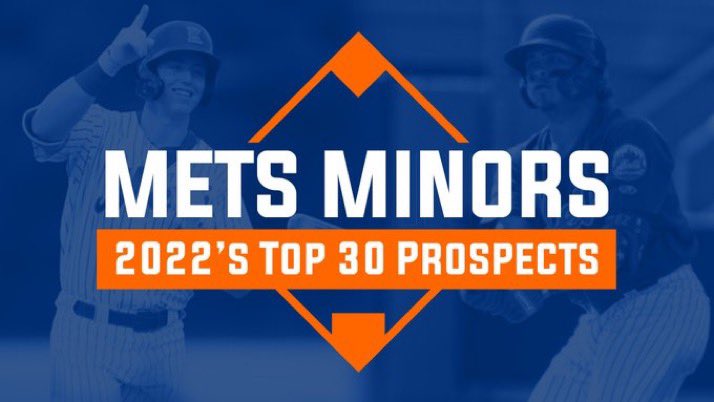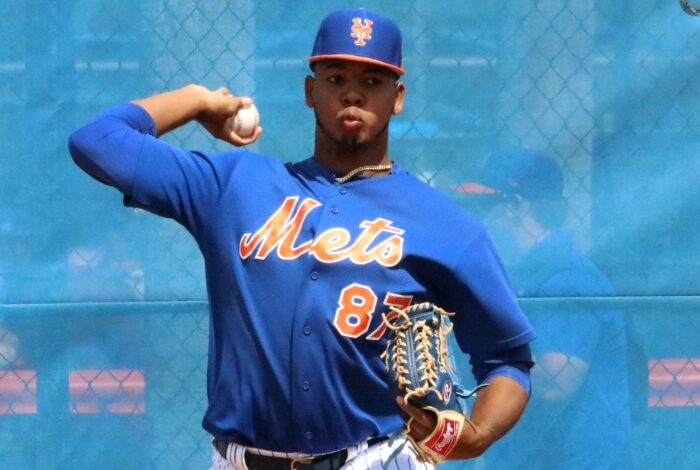
22. Josh Walker, LHP
B/T: L/L Age: 27 (12/1/1994)
Ht: 6’6 Wt: 225 LBS
Acquired: Mets 37th round pick, 2017 (New Haven)
ETA: 2022 Previous Rank: N/A
2021 Stats (Brooklyn/Binghamton/Syracuse): 9-4, 3.73 ERA, 21 G, 20 GS, 115.2 IP, 1.02 WHIP, 7.63 K/9, 2.26 BB/9
It’s always a great feat when draft picks taken in the far tail-end rounds of the draft make it anywhere close to big league relevancy, let alone turning out to be productive big league mainstays. But the Mets have made a bit of a habit of this of late, and their 37th round pick from their 2017 draft class could be on the cusp of his first taste of big league action.
Josh Walker, 27, has arrived out of the blue and onto the scene of upper level pitching depth in the Mets organization on the backs of his impressive 2021 campaign that culminated in making nine starts at the highest rung of the ladder in Triple-A Syracuse. The lanky 6’6 left-hander would appear to have the sturdy frame of a power pitcher, but this young man is as much finesse as brute force.
Walker operates with a long arm swing from a high 3/4 slot and simple, very repeatable delivery. It’s a three pitch mix for Walker, who keeps hitters off-balance with a low 90’s fastball that he can move to all four corners of the strike zone, a low 80’s slurvy breaking ball, and a changeup. Everything plays up due to Walker’s ability to command all of his pitches well, consistently inducing soft contact by changing speeds and eye levels. Walker’s fastball plays up as well due to significant extension he gets down the mound.
https://twitter.com/MetsFarmReport/status/1421166792794382338?s=20&t=UvVhGvIcW4RU4tyvuTIjbw
Walker does not possess the raw stuff to get away with pitches in the heart of the strike zone and he must make up for it by limiting traffic on the bases. Walker did this exceptionally well last year in his stops at High-A Brooklyn and Double-A Binghamton with a BB/9 under 2.00 at each stop. Walker’s repeatable skill of inducing soft contact held as he was promoted to Triple-A, maintaining a BABIP beneath .260 across each of his three stops last year.
However, as Walker faced more advanced hitters with more curated approaches at the plate, his BB/9 climbed to 3.22 at Syracuse. Combining that with the fact that his homerun per flyball ratio (HR/FB) increased at each rung up the ladder (4.3%, 6.4% and finally 8.6%), it appears that by the time Walker got to Triple-A, hitters were better equipped to do damage against his repertoire. Or conversely, if Walker’s control began to waver as he far surpassed any previous innings total in his career, hitters were better able to hunt pitches as Walker fell behind in more counts.
Time will tell whether Walker’s regression at Triple-A was merely fatigue or an indicator of a need for adjustments. In a player development landscape that has gotten more efficient at finding latent velocity or re-shaping breaking pitches in a way that makes them significantly more effective, both of these avenues would potentially be a game-changer for Walker.
Even at Walker’s advanced age for a prospect, the journey to improve can never end or even slow down, and Walker’s base skills have already gotten him to the cusp of contributing to the big league club. Not bad for a 37th round pick.
 Photo by Ed Delany, MMN
Photo by Ed Delany, MMN
21. Junior Santos, RHP
B/T: R/R Age: 20 (8/16/2001)
Ht: 6’8 Wt: 244 LBS
Acquired: International Free Agent, Dominican Republic (2017)
ETA: 2024 Previous Rank: 14
2021 Stats (St. Lucie): 6-6, 4.59 ERA, 21 G, 16 GS, 96.0 IP, 1.521 WHIP, 7.41 K/9, 3.56 BB/9
It’s been a few years now since Junior Santos burst into the consciousness of Mets minor league fans with his impressive-beyond-his-years showing in the Dominican Summer League in 2018. Then, just a skinny, barely 17-year-old with a gigantic frame, Santos was touching the upper 90s with his fastball, throwing strikes, and showing nascent feel for a breaking ball and changeup.
The 2019 season saw a major hurdle in the young Santos’ development; however, as he was given an aggressive assignment to the now defunct, hitter-friendly Appalachian League and saw both his velocity and strike-throwing regress. Santos was still full of physical and skills projection as he entered the spring of 2020 all of 18-years-old.
The pandemic then wiped away his season, and the next Santos would surface would be in 2021 with his first exposure to full-season competition as a 19-year-old in May of last year.
All told, 2021 was a positive, if not groundbreaking step in Santos’ development. Santos has stayed healthy, accumulating 96.0 innings as a starter last year, and his statistical performance improved each successive month of his season. Santos wrapped up his campaign with an ERA of 3.86 in August and 3.50 in September after posting ERA’s over 4.00 in May, June and July.
From a physical standpoint, Santos appears to be filling out and adding good strength to his frame, the likely reason his velocity rebounded last year to average 93 mph after only topping out there when last seen in 2019. Santos now frequently touches 95 mph with his sinking fastball, and clocked an occasional 96 or 97 mph last season.
Santos generates his fastball velocity from a short arm swing that slings across his body from a lower 3/4 slot. His delivery features moderate effort and downhill extension and Santos repeats it well enough to be generally around the strike-zone. Santos appears to have some energy leak through his lead leg block and some stiffness in his motion, and there could be a viable path to uncovering some more latent velocity with further mechanical refinement.
Delving into Santos’ current assortment of pitches, it’s a sinker-slider-changeup mix that he likes to mix up well. He will even occasionally add a hitch in the timing of his delivery to throw off a hitter. Santos gets primarily sinking and tailing action on his fastball, a product of his arm slot and solid-average raw spin of about 2300 rpm. He was able to run a solid ground ball rate last year of 49% with this movement profile, but it is also partly responsible for his less than inspiring 7.41 K/9 last season.
Santos’ primary breaking pitch, a gyro-slider with mostly vertical drop, actually features less raw spin, about 2100 rpm on average, than his fastball. While thrown sufficiently hard in the low 80’s and able to garner some tight, late break from it’s spin profile, it does not harness any sweeping action that is becoming seen as optimal by pitching labs and progressive MLB clubs.
Santos already throws from the lateral slot that would abet adding more sweep to his breaker, but he would need to find a new grip to execute this plan. His ability to spin his fastball sufficiently well also portends a decent chance of generating more raw spin with a different grip.
Meanwhile, Santos creates around 13-15 inches of run on his firm changeup, amd the pitch is thrown in the mid 80s with minimal tumbling action, currently creating around 8-9 mph of velocity separation off of his sinker. The pitch projects for now as a fringe-average major league offering, to be utilized primarily against left-handed batters, spotted to the outside corner.
All told, Santos largely held serve in 2021 with ample time and avenues for jumps in his development ahead. With his velocity and control back on track and youth still on his side, Santos will likely enter 2022 as a key member of the High-A Brooklyn Cyclones’ rotation.
Santos will be under the reins of a minor league pitching program that is yet again under brand new leadership in Jono Arnold, who was brought over this winter from the Texas Rangers organization. There are almost limitless possibilities still in the young Santos’ development ahead, and 2022 will be fascinating step to see unfold.

